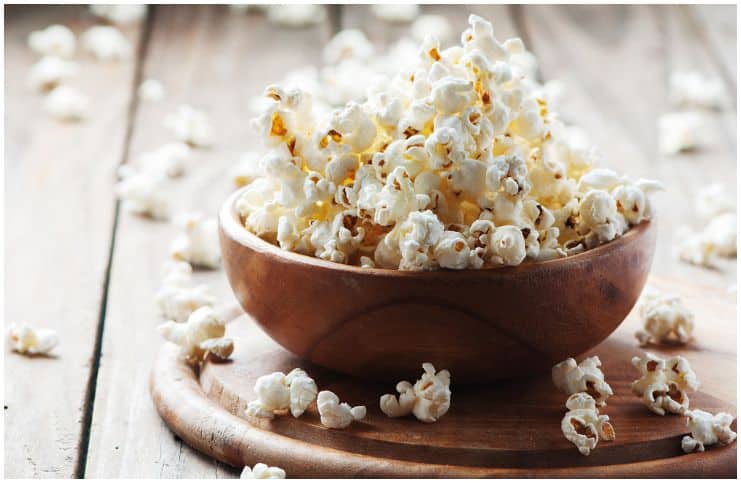Corn, considered both a grain and a vegetable, has a long history dating back to ancient times. It was a staple in the Mayan, Aztec, and Inca civilizations — to name just a few of the most famous and oldest.
In the present day, around 500 million kilograms are consumed in the U.S. every year, making it one of the most popular snack food by volume in the country.
Many studies have shed light on the multiple health benefits as well as the side effects of this snack.
Side Effects of Popcorn
High In Calories
A usual large pack of popcorn (280g) available at some cinemas is coming with a total of 1512 calories, 22 grams of protein, and 104 grams of fat.
Furthermore, a 2009 report by CSPI established that a medium-sized popcorn at a popular movie theater had 1,200 calories and 60 grams of saturated fat.
Salt
A large bucket of salted cinema popcorn contains 3g of salt (half of the recommended daily intake). The overconsumption of salt is becoming increasingly usual in the American diet which ultimately leads to high blood pressure. The effect is stronger in people who already have high blood pressure.
Prolonged high blood pressure raises the chance of heart disease, stroke, heart failure, and kidney disease. Another adverse effect of intaking too much salt is edema, which occurs when the body retains an excess of fluid in an attempt to balance out the extra sodium.
Saturated and Trans Fats
Many brands of microwave popcorn are made using partially-hydrogenated or hydrogenated oils (because they are more shelf-stable), that contain harmful trans fats (a large pack contains on average 29 grams of trans fats).
Studies have associated the consumption of trans fats to an increased risk of heart disease and other chronical diseases, such as type 2 diabetes.
In addition, a diet rich in trans fats causes a redistribution of fat tissue into the abdomen and leads to higher body weight.
Tooth Damage
Most bags of popcorn have a few unpopped kernels, and those hard pieces can chip and crack teeth.
Teeth frequently break when in the process of eating something thought to be soft, an unexpected hard object is encountered and the force of impact overcomes a tooth’s integrity.
Additionally, kernels can get stuck between teeth causing gum irritation. Eat small amounts at a time and don’t eat hard unpopped kernels.
PFOA
Microwave popcorn bags are usually lined with perfluorooctanoic acid, also known as PFOA, which is a toxic substance labeled as a human carcinogen.
PFOA is also strongly implicated in thyroid problems, endocrine disruption, ADHD, a higher risk of cardiovascular disease, autoimmune disorders, and low birth weight.
Inhaling this chemical has been strongly associated with severe obstructive lung disease, according to research done by the Centers for Disease Control.
Diacetyl
Diacetyl is both an artificial substance used to lend a buttery flavor to foods like chips, margarine, and popcorn and a substance found in beer, butter, and other fermented foods.
In 2004, CDC reported a few cases of bronchiolitis obliterans (an inflammatory obstruction of bronchioles) in workers in a microwave popcorn plant in Missouri. This chemical is also added by some e-cigarette companies to complement flavorings such as maple, vanilla, coconut and more.
Propyl Gallate
Propyl Gallate is an artificial food additive (to keep the oil from going rancid during storage), that is also used in pharmaceuticals and cosmetics.
According to a 2009 study at the Department of General and Inorganic Chemistry, University of Parma, Italy, this compound is a mild endocrine disruptor even at very low concentrations.
TBHQ
TBHQ (or tertiary butylhydroquinone) is used in many foods, ranging from crisps to crackers and other fast foods.
TBHQ is used to greatly extend the storage life of foods and delay the onset of rancidness. Side effects include DNA damage, vomiting, nausea, tinnitus, collapse, delirium and an increased risk of stomach cancer.
Note
Popcorn is a potentially dangerous food that should not be fed to children under the age of 3, according to the National Institutes of Health.
More importantly, corn that is not sprouted or soaked prior to cooking contains lectins and phytic acid that can inflame digestion if ingested to excess.
Ways to Keep Popcorn Healthy
If you cook it properly and choose the right variety, this snack can be relatively nutritious and provide a valuable source of fiber and antioxidants, such as polyphenols that have numerous health benefits and are responsible for protecting the body from various dangerous conditions and diseases.
In addition, this snack contains ferulic acid that’s also found in rice, beans, corn, wheat, or barley.
Ferulic acid has multiple beneficial effects, such as – protection against type 2 Diabetes Mellitus, cancer, cardiovascular and neurodegenerative diseases due to its powerful anti-inflammatory and antioxidant properties.
Buy Organic
Consider buying organic popcorn, which is not genetically modified and will not have pesticide residues common to conventionally grown corn. Corn is a crop that is heavily covered in insecticides, pesticides, herbicides, fungicides, and fertilizers, plus there is no mandatory labeling of GMOs in the U.S.
Stay away from highly processed oils, such as canola oil, soybean oil, and vegetable oil. The best oil choice for making your organic homemade popcorn is organic virgin olive oil.
In addition, stay clear of microwaveable varieties.
Healthy Popcorn Recipe
Start with organic popping corn, then top with organic olive oil and unrefined sea salt. A healthier method to prepare this snack would be to air-pop the popcorn in an air popper.
Additional flavors can be added, such as black pepper, fresh lemon or lime zest, paprika, herbs such as chives, basil, and parsley.
Bottom Line
Microwave popcorn is convenient, but it has its adverse effects, even if you choose the low-fat varieties. Even though homemade popcorn is a healthy snack choice, don’t overdo it.
References https://www.ncbi.nlm.nih.gov/pubmed/18474946. http://circ.ahajournals.org/content/115/14/1858 https://cspinet.org/new/200911182.html http://pubs.acs.org/doi/abs/10.1021/tx800048m




thank it very helpful